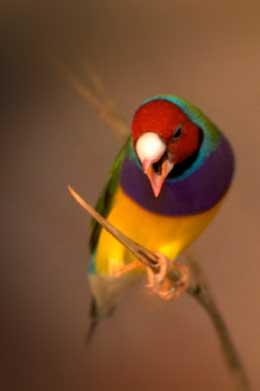
Colour intimidation in finches is innate, not learned.
Finches instinctively avoid competitors coloured red, rather than learning to fear the colour during their upbringing, Australian research concludes.1
The results are tempting researchers to suspect that in other animals, including ourselves, red's aggressive and intimidating character might also be hard-wired into brains from birth.
Dozens of experiments have shown that red intimidates competitors. In humans, wearing red improves chances of winning at sports.2 Studies have also revealed that red is associated with aggression and dominance in fish, reptiles and birds.3,4 But whether fear of red is innate or learned is an "unresolved mystery", says Robert Barton, an anthropologist at the University of Durham, UK.
Sarah Pryke of Macquarie University in Sydney tested this question in Australian Gouldian finches (Erythrura gouldiae). As adults, the finches develop either red or black heads, a genetically determined trait. The red-headed birds are aggressive, dominant and avoided by others.
To find out whether these traits were learned or inborn, Pryke examined competition between young Gouldian finches — whose heads, yet to blossom into coloured adulthood, are all dull grey.
Red destiny
She first raised finches that were genetically destined to be red-headed with black-headed parents, raised others that were genetically destined to be black-headed with red-headed parents, and left still other finches to be raised by parents of the same colour group. In contests staged between these young birds over food, it was body size rather than genetic destiny or rearing environment that decided the winner.
The still-uncoloured juveniles were then either allowed to mingle with adult red- and black-headed birds, or placed in isolation. They finally had their heads randomly painted red, black or a blue control colour.
Pryke again set pairs of hungry birds to fights over food. After the conflict, she inferred stress in individual birds by measuring blood levels of the hormone corticosterone.
Red-painted juveniles won contests with non-red juveniles 81.5% of the time, Pryke reports, regardless of what coloured head they would ultimately grow up to have. And juveniles facing red-painted opponents showed corticosterone levels 57.6% higher than those of birds that faced blue or black-headed opponents.
Don't mess with a redhead
"How the experimentally reddened finches won contests was interesting: their opponents simply moved out the way. It was not that the birds with fake red heads were suddenly more aggressive," recalls Pryke.
The results suggest that birds don't just avoid red because they have learned from experience to fear it. Rearing conditions and prolonged experience with aggressive red adults made no difference to an individual's aggressive response or stress levels.
"This suggests that Gouldian finches hatch 'knowing', as it were, that birds with red should be avoided," says Pryke.
"There are numerous examples in the literature suggesting an evolutionary bias towards red as an innate signal of aggression, [but] Pryke is the first to show explicitly and experimentally that this is indeed true … regardless of genetic and environmental background," says Mats Olsson, who works on evolutionary ecology at the University of Wollongong in New South Wales, Australia.
Red for a reason?
What remains unclear is why red is the colour of intimidation. White and blue are as commonly used as warning colours in plants and animals as red, says Pryke — so it's surprising that an innate fear of red should emerge from natural selection.
"There could be something about red that is particularly costly to produce or maintain, therefore making it very likely to be an 'honest' signal that other animals have to respect," thinks Barton. Many primates, including humans, show anger or dominance by bringing oxygenated blood to the surface of the skin. This creates a red colouration but at the cost of shunting blood away from core tissues.
Barton also suggests that the high visibility of becoming red, which increases the risk of being picked out by predators or rivals, may suggest to others of the same species that an animal is tough enough to cope with being more noticeable.
"Considering this study and all of those associated with red uniforms in games2, it is tempting to suspect that in humans, as in birds, it is also innate for red to signal aggression and intimidation," adds neuroscientist Mihai Moldovan, at the University of Copenhagen.
References
- Anim. Behav. published online. doi: 10.1016/j.anbehav.2009.05.013 (2009).
- Nature, 435, 293 (2005)
- Animal Behaviour, 74, 337-341 (2007)
- , Behavioural Ecology, 13, 622-631 (2002)




